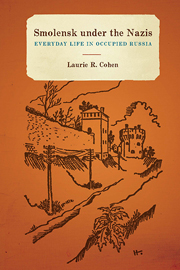Book contents
- Frontmatter
- Contents
- Acknowledgments
- Abbreviations
- Introduction
- Part 1 Methodologies
- Part 2 A Record of the War and Occupation
- Part 3 Popular Attitudes, Propaganda, and Enemy Imagery
- 6 Between Stalinists and Nazis: The Long-Term Aims and Long-Lasting Effects of Occupation
- 7 Propaganda and Persuasion
- 8 Group Perceptions, Oral Narratives
- 9 Sex/Gender Relations and Youth Experiences
- Part 4 Restoration and Reconstruction
- Conclusion
- Notes
- Bibliography
- Index
9 - Sex/Gender Relations and Youth Experiences
from Part 3 - Popular Attitudes, Propaganda, and Enemy Imagery
Published online by Cambridge University Press: 05 December 2013
- Frontmatter
- Contents
- Acknowledgments
- Abbreviations
- Introduction
- Part 1 Methodologies
- Part 2 A Record of the War and Occupation
- Part 3 Popular Attitudes, Propaganda, and Enemy Imagery
- 6 Between Stalinists and Nazis: The Long-Term Aims and Long-Lasting Effects of Occupation
- 7 Propaganda and Persuasion
- 8 Group Perceptions, Oral Narratives
- 9 Sex/Gender Relations and Youth Experiences
- Part 4 Restoration and Reconstruction
- Conclusion
- Notes
- Bibliography
- Index
Summary
Our daughters, sisters and brides languished in slavery…. Smolensk girls lived in constant trepidation. Every day, any one of them could be sent away…. No family in Smolensk survived the black nights of the occupation, which carried off daughters, sisters, nieces and close cousins.
—Rabochii put', October 8, 1943, 2Fraternizing with “the Enemy”: Female-Male Interactions
In April 1942 there were 29,260 officially registered Soviet workers in Smolensk: 14,817 women, 6,361 men, 4,093 girls, and 3,989 boys. Apart from omitting all German residents (including estimates of up to 50,000 soldiers) and young children, these figures also exclude the official Soviet nonworking adult population—namely, the elderly, invalids, and mothers with small children. But based on these statistics, at least insofar as the majority of civilians of occupied Smolensk were concerned, there were twice as many women as men, clearly more teenagers than men, and roughly the same number of boys as girls. In other words, the civilian population (not including another 5,000–6,000 workers with jobs in the outskirts, such as in Krasny Bor, whose age and sex are unknown) was strongly female (2:1), with a relatively large juvenile population (two teenagers to every five adults).
- Type
- Chapter
- Information
- Smolensk under the NazisEveryday Life in Occupied Russia, pp. 220 - 232Publisher: Boydell & BrewerPrint publication year: 2013



